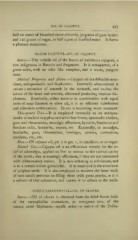Page 489 - My FlipBook
P. 489
OIL OF CAJUPUT.
4S7
half an ounce of blanched sweet almonds, 30 grains of gum Arabic
and 1 20 grains of sugar, in half a pint of distilled water. It forms
a pleasant demulcent.
OLEUM CAJUPUTI—OIL OF CAJUPUT.
Source.—The volatile oil of the leaves of melaleuca cajuputi, a
tree indigenous in Batavia and Singapore. It is transparent, of a
green color, with an odor like camphor, and a warm, pungent
taste.
Medical Properties and Action.—Cajuput oil is a diffusible stim-
ulant, antispasmodic and diaphoretic. Internally administered it
causes a sensation of warmth in the stomach, and excites the
action of the heart and arteries, afterward producing copious dia-
phoresis. Externally, either alone or in combination with equal
parts of soap liniment or olive oil, it is an efficient rubefacient
and stimulant embrocation. Its use is becoming more common.
Therapeutic Uses.—It is employed internally as an antispas-
modic stimulant in typhus and other low fevers, spasmodic cholera,
gout and rheumatism, neuralgic affections, hysteria, flatulence and
flatulent colic, headache, nausea, etc. Externally, in neuralgia,
headache, gout, rheumatism, lumbago, sprains, contusions,
paralysis, etc., etc.
Dose.—Of cajuput oil, gtt. j to gtt. v, in emulsion, or on sugar.
Dental Uses.—Cajuput oil is an efficacious remedy for the re-
lief of odontalgia, applied on lint or cotton to the carious cavity
of the tooth ; also in neuralgic affections, if they are not connected
with inflammatory action. It is non-irritating to soft tissues, and
is to a certain extent germicidal. It is employed in the treatment
of pulpless teeth. It is also employed to moisten the inner walls
of root canals previous to filling them with gutta percha, as it is
a solvent of that substance, and causes it to adhere to the walls.
OLEUM CARYOPHYLLI—OIL OF CLOVES.
Source.—Oil of cloves is obtained from the dried flower buds
of the caryophyllus aromaticus, an evergreen tree, of the
natural order Myrtacea—myrtle order—a native of the Indies.


